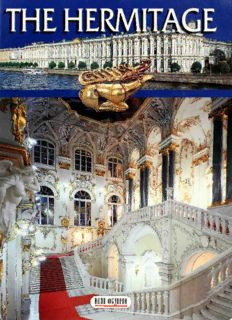
The Hermitage: A Stroll Around the Halls and Galleries PDF
Preview The Hermitage: A Stroll Around the Halls and Galleries
f«" *lw1' j 'J ":£'I'M """ THE HERMITAGE A STROLL AROUND THE HALLS AND GALLERIES AN ILLUSTRATED GUIDE-BOOK Ivan FiodorovArt Publishers ST PETERSBURG 2005 Foreword by Mikhail Piotrovsl<y Introduction by Vladimir Matveyev Selection and text by Sergei Vesnin, Sophia Kudriavtseva and Tatyana Pashkova English translation by Paul Willianns Designed by Nikolai Kutovoy Colourcorrection by Liubov Kornilova Computertype-setting byYelena Morozova Photographs by Darya Bobrova, Leonid Bogdanov, Pavel Demidov, Sergei Falin, Alexander Gronsky, Leonard Kheifets, Victor Savik, Georgy Shablovsky, VladimirTerebenin and Oleg Trubsky Edited by Maria Lyzhenkova and Valery Fateyev (English translation) Managing editor Sergei Vesnin ISBN 5-93893-050-2 (Softcoveredition) ISBN 5-93893-059-6 (Hardcoveredition) Printed and bound in Russia STROLLING THROUGH THE HERMITAGE The name of our museum comes from the French and means "a place of solitude". The times when it was the Tsar's private museum are long past, yet even today the Hermitage with its millions ofvisitors each year is one ofthe few places where it is possible to find solitude in a dialoguewith world culture and Russian history. Itis morethanjustcontactwith the sublime taking us away from everyday concerns: the Hermitage has its own special atmosphere that awakens the finest elements in the human spirit. Inthe Hermitageyou can breathe in differentcultures, befascinated bytheirdistinctivefeatures. You can admire masterpieces thatstand above all national and cultural differences. You can reflect on episodes in Russian history, manyofwhich took place, at least in part, within these walls. The Hermitage is to a large extent a unique museum precisely because the history of the wortd embodied in its cultural attainments is here fascinatingly interwoven with the spirit ofour own, Russian history. The ghosts ofgreat artists, famous and anonymous, wander the halls of the Hermitage together with the shades of tsars and courtiers, soldiers and diplomats, writers and revolutionaries, who have lefta living memoryofthemselves here forever. The museum is so huge and the impressions it generates so varied that it takes many visits to get to know it. Strolling through the Hermitage is probably the greatest pleasure it offers us: to pass unhur- riedly from hall to hall, from the historical state rooms to the masterpieces ofAncient sculpture or Dutch painting, thinking as you go about Matisse or Napoleon, Rembrandt or Stolypin, and, inevitably, about Catherine, whose will and taste brought the museum into being. Such a stroll is always full of surprises, even for those who know the Hermitage well. Your eye is suddenly caught by an elaborately carved chair you never noticed before. The sun falling in a different way gives a new vision of a familiar painting. You wander into one of the many temporary exhibitions held in the Hermitage. On the otherhand, ifworks have been removed forexhibition elsewhere, their place might be taken by others from the museum stores. The Hermitage is inexhaustible and generous to those who love it. You can come here with a specific aim, orjust to wanderwherever the fancy takes you. In the Hermitage you can be constantly gazing from side to side or lost in your own thoughts. You can view the paintings and statues, but equally you can admire the floors and ceilings. You can make yourway slowly, taking in every detail, or quickly, eager to reach some favourite, familiar spot. Yet there are few spectacles in the wortd more attractive than the views from the Hermitage windows: the Neva with the Peter and Paul Fortress and the Spit of Vasilyevsky Island, Palace Square, the Admiralty... The Hermitage entices, fascinates, charms. It never disappoints anyone. The Hermitage is an extensive museum with man—y layers to it. It has everything: both spir- itual ennchment and new knowledge for any visitor child, teenager, preoccupied adult, and thoughtful pensioner. The museum is as welcoming to refined intellectuals and inexpenenced provincials as it is to venerable scholars, to those still studying and discovering the wortd and thosewho are certain they have penetrated its deepest secrets. The Hermitage is equallyopen to all. Although an anstocrat and a snob, the Hermitage is the most democratic of museums, one where everyone finds something for his or her self. The Hermitage has lived a very long and complicated existence. It has expenenced wars and revolutions, fires, thefts, sales, neglect and lack of understanding. It has also known the emo- tional uplift of construction and the gambles involved in collecting, the pleasure and pnde of saving somethi—ng, self-sacrificing love and fanatical adoration. Losses and gains, failures and achievements all ofthem are to be found in the life ofthe Hermitage today aswell. Formore than 200 yearsthe museum has earned out its sacred dutyto be the guardian and curator of wortd culture on Russian soil. The Hermit—age has itself become one of the most characteristicfeatures ofthe Russian cultural tradition its universalityfused with uniqueness. Italways has something to saytothosewho visit, no matterhow manytimesthey have been. Welcome to the Hermitage. MikhailPiotrovsky Directorofthel-lermitage Viewofthe WinterPalace fromPalace Square NewHermitage TheRaphaelLoggias WinterPalace TheMalachite Room i^.il
Description: